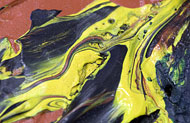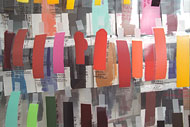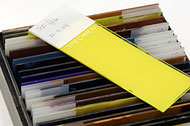A project of the Modern and Contemporary Art Research Initiative

|
|
This long-term project aims to increase significantly the information that is available to conservators on modern paints, so that ultimately better-informed decisions can be made on how best to preserve these materials.
To date, the project has focused on three main areas:
- an assessment of analytical methods for modern paints;
- a study of the physical and surface properties of modern paints;
- an evaluation of cleaning methods for modern paintings.

|
|
Background
Over the last seventy years or so, a staggering array of new pigments and binders have been developed and used in the production of paint. There are now hundreds of pigments available to paint formulators, facilitating the production of any desired combination of color and transparency in paint. The introduction of synthetic binders—most notably acrylic, alkyd, polyvinyl acetate, and nitrocellulose—has resulted in paints that exhibit fast drying times, reduced yellowing tendencies, a vast range of appearances and handling properties and, in the case of emulsion formulations, great flexibility and the elimination of organic solvents as thinners and diluents. Many artists have utilized these modern paints (including house paints and others that were never intended specifically for artists' use) and have explored and exploited their distinct handling and optical properties.
However, the enormous diversity in materials used in modern paints has important and direct implications for their conservation, since each type of paint is likely to display its own unique set of properties, which will govern their responses to aging, environmental conditions, and conservation treatments. So, for example, a perfectly safe cleaning treatment on one type of paint may be catastrophic for another.

|
|
Overview
Art works from the 20th century represent the artistic legacy of our time. In order to pass these works along to future generations, it is essential to understand as comprehensively as possible the factors that govern their behavior and stability, and those that could contribute to their deterioration. Designing the optimum means for the preservation and restoration of works of art is an extremely complex task that requires a thorough understanding of all the materials with which they were made and the way in which these materials react with one another, with environmental conditions, and with conservation treatments. This information is best obtained with a combination of monitoring the behavior of actual art objects and an extensive analytical program that closely examines test materials subjected to artificial aging and/or trial treatments.
The project brings extensive scientific expertise and equipment to bear in the areas of materials identification, characterization and cleaning. The combined results from each component of the project will assist conservators in studying the techniques of modern painters, selecting appropriate display and storage conditions for these works of art, as well as significantly contributing to the development of safe and effective cleaning methods and other conservation treatments for modern paints.
This integrated collaborative project was initiated in 2002 by Tate in London, the National Gallery of Art (NGA) in Washington, D.C., and the Getty Conservation Institute (GCI), and now involves a much larger network of research institutions and modern art galleries around the world. One of the key moments in the project to date was the Modern Paints Uncovered symposium, held at Tate Modern in 2006, at which many of the accomplishments in this research area were presented. The proceedings from this symposium are now available and provide the best overview of the project to date.
This project is part of the GCI's Modern and Contemporary Art Research initiative, which takes a broad approach to the needs of this area of conservation, including a range of scientific research projects but also a number of conferences, events, and meetings that are intended to promote discussion of these issues and to help disseminate information.
Page updated: July 2009
